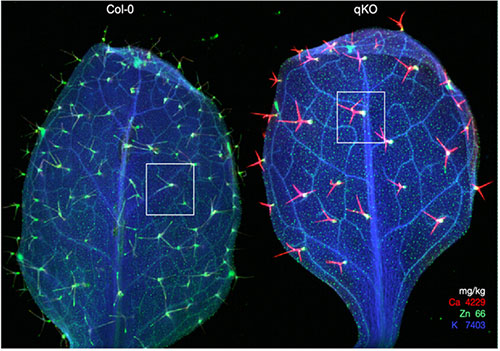The Role of Positive-Ion Exchange in Arabidopsis
August 30, 2024
 enlarge
enlarge
XRF image of calcium (red), zinc (green), and potassium (blue) in 14-day-old leaves of wild-type Arabidopsis (Col-0) and quadruple-mutated (qKO). (Credit: Plant Cell Environ. 47, 557-573 (2024))
The Science
Researchers establish that hydrogen-ion and calcium-ion (Ca2+) exchange in Arabidopsis plant cells contribute to plant growth, elemental distribution, and stress responses.
The Impact
The work shows the many functions of ion exchange in plants and how suppressed ion uptake can improve anoxia tolerance.
Summary
An international team of researchers has investigated the role of positive-ion exchange within the cells of Arabidopsis, a small weed often used in research due to its similarity to more complex crop plants in terms of fundamental mechanisms. Through deliberate mutations that suppressed ion uptake, they observed intriguing changes in the plants' leaf composition and growth patterns. Surprisingly, the mutated plants displayed enhanced tolerance to anoxia, a condition of severe oxygen deprivation often encountered during flooding, which is a huge economic problem for farmers.
Positive ions like hydrogen and calcium play pivotal roles in plant physiology, shuttling in and out of cells and between them via specialized transporters within cellular membranes. This intricate dance of ions is crucial for normal growth and functioning.
Contrary to the notion that more ion exchange is always better, recent studies, including this one, challenge this assumption. By mutating the plants to eliminate four key ion transporters, the researchers uncovered unexpected benefits. Their findings hint that curtailing ion exchange, particularly calcium, could trigger positive outcomes in stress response, notably boosting tolerance to anoxia (oxygen deprivation).
The researchers employed various analytical techniques, including two imaging techniques: inductively coupled plasma mass spectrometry and x-ray fluorescence (XRF) microscopy. The latter was conducted at the X-ray Fluorescence Microscopy (XFM) beamline at the National Synchrotron Light Source II, a U.S. Department of Energy (DOE) Office of Science User Facility at Brookhaven National Laboratory. Both techniques offer detailed insights into the elemental composition, distribution, and concentration within the plant samples.
Results showed that, in the mutated plants, alterations were observed in the concentrations and distributions of several essential mineral elements, including calcium, potassium, manganese, copper, and zinc. Notably, the response of calcium was the most pronounced, with a significant decrease in its uptake by the cells.
This research could pave the way to breeding crop plants to be more flood tolerant, saving farmers millions of dollars.
Download the research summary slide (PDF)
Contact
Kendal D. Hirschi
Baylor College of Medicine
kendalh@bcm.edu
Publications
Mathew, I.E., Rhein, H.S., Yang, J., Gradogna, A., Carpaneto, A., Guo, Q., Tappero, R., Scholz-Starke, J., Barkla, B.J., Hirschi, K.D., Punshon, T. "Sequential removal of cation/H+ exchangers reveals their additive role in elemental distribution, calcium depletion and anoxia tolerance." Plant Cell Environ. 47, 557-573 (2024) DOI: 10.1111/pce.14756
Funding
This research used the X-ray Fluorescence Microprobe (XFM) beamline (4-BM) of the National Synchrotron Light Source II, a US Department of Energy (DOE) Office of Science User Facility operated for the DOE Office of Science by Brookhaven National Laboratory under Contract No. DE-SC0012704. This work was supported by grants to Tracy Punshon and Kendal D. Hirschi from the National Science Foundation (1557890), and grants to Kendal D. Hirschi from USDA (3092-51000-061-00D) and National Institute of Health (R03 AI149201-02). This research used beamline 4-BM of the National Synchrotron Light Source, an US Department of Energy (DOE) Office of Science User Facility operated for the DOE Office of Science by Brookhaven National Laboratory under Contract No. DE-AC02-98CH10886. ICP-MS analysis was carried out at the Dartmouth Trace Element Core Facility, which is supported by Dartmouth Cancer Centre with NCI Cancer Centre Support Grant 5P30 CA023108.
2024-22071 | INT/EXT | Newsroom









